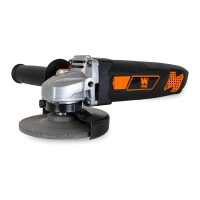5
SPECIFIC RULES FOR GRINDING
7. Do not use a grinding wheel that is larger than the maximum recommended size for your tool. Avoid using worn
down and damaged wheels from larger grinders. Wheels intended for larger angle grinders are not suitable for the
high speed of a small angle grinder, making these wheels burst easily.
8. Do not use depressed hub grinding wheels for cut-off operations. Depressed hub wheels are not intended for side
loading and may shatter under certain loads.
9. Do not use this tool with a woodcarving blade. Such blades create frequent kickback and a loss of control.
10. Wear proper apparel while using the grinder. Face shields (or at least safety goggles,) dust masks, leather gloves
and a shop apron capable of withstanding small wheel or workpiece fragments should be worn at all times.
11. Position the cord away from the spinning grinding wheel or any other sanding accessory. Do not wrap the cord
around your arm or wrist. If you lose control and have the cord wrapped around any appendage, it may cause injury.
Avoid bouncing and snagging the wheel, especially when working on corners, sharp edges, etc. This can cause a loss
of control and create kickback.
12. Regularly clean the tool’s air vents with compressed air. Excessive accumulation of powdered metal inside of the
motor housing can cause electrical failures. Do not grind or sand near flammable materials. Sparks from the wheel
can ignite these materials.
WARNING: some dust created by power sanding, sawing, grinding and drilling contains chemicals known
to cause cancer, birth defects, or other reproductive harm. To reduce your exposure to these risks, work in
a well-ventilated area with approved safety equipment including dust makes that are specially designed to
filter out microscopic particles.
This tool vibrates during use. Repeated or long-term exposure to vibration may cause temporary or permanent
physical injury, particularly to the hands, arms and shoulders. To reduce the risk of any vibration-related injury:
First be examined by a doctor and then have regular medical check-ups to ensure medical problems are not being
caused or worsened from use. Pregnant women or people who have impaired blood circulation to the hand, past
hand injuries, nervous system disorders, diabetes, or Raynaud’s Disease should not use this tool. If you feel any
symptoms related to vibration (such as tingling, numbness, and white or blue fingers), seek medical advice as soon
as possible.
Do not smoke during use. Nicotine reduces the blood supply to the hands and fingers, increasing the risk of
vibration-related injury.
Wear suitable gloves to reduce the vibration effects on the user.
Use tools with the lowest vibration when there is a choice.
Take vibration-free breaks during each day of work.
Grip tool as lightly as possible (while still keeping safe control of it). Let the tool do the work.
To reduce vibration, maintain the tool as explained in this manual. If any abnormal vibration occurs, stop use
immediately.

